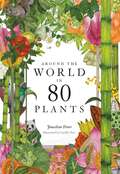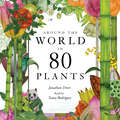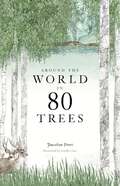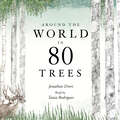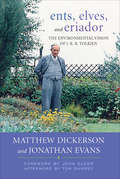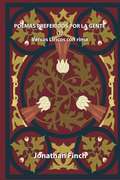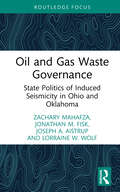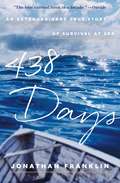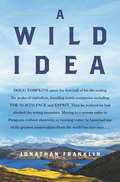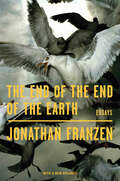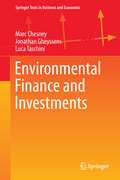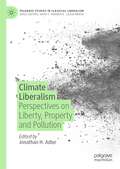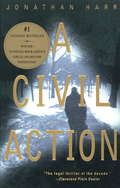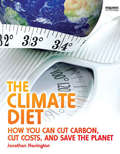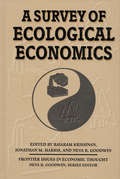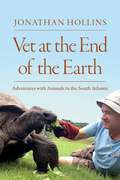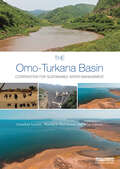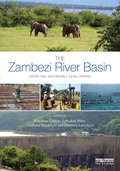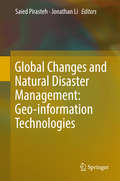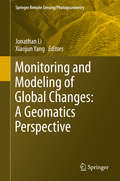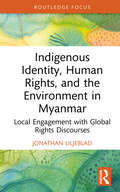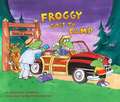- Table View
- List View
Around the World in 80 Plants
by Jonathan DroriAn inspirational and beautifully illustrated book that tells the stories of 80 plants from around the globe.In his follow-up to the bestselling Around the World in 80 Trees, Jonathan Drori takes another trip across the globe, bringing to life the science of plants by revealing how their worlds are intricately entwined with our own history, culture and folklore. From the seemingly familiar tomato and dandelion to the eerie mandrake and Spanish 'moss' of Louisiana, each of these stories is full of surprises. Some have a troubling past, while others have ignited human creativity or enabled whole civilizations to flourish. With a colourful cast of characters all brought to life by illustrator Lucille Clerc, this is a botanical journey of beauty and brilliance.'A beautiful celebration of the plants and flowers that surround us and a quiet call to arms for change' The Herald'This charming and beautifully illustrated book takes readers on a voyage of discovery, exploring the many ingenious and surprising uses for plants in modern science and throughout history' Kew Magazine'With beautiful illustrations from Lucille Clerc, this captivating book traverses the globe via plants: nettles in England, mangoes in India and tulips in the Netherlands' Daily Mail
Around the World in 80 Plants
by Jonathan DroriAn inspirational and beautifully illustrated book that tells the stories of 80 plants from around the globe.In his follow-up to the bestselling Around the World in 80 Trees, Jonathan Drori takes another trip across the globe, bringing to life the science of plants by revealing how their worlds are intricately entwined with our own history, culture and folklore. From the seemingly familiar tomato and dandelion to the eerie mandrake and Spanish 'moss' of Louisiana, each of these stories is full of surprises. Some have a troubling past, while others have ignited human creativity or enabled whole civilizations to flourish. With a colourful cast of characters all brought to life by illustrator Lucille Clerc, this is a botanical journey of beauty and brilliance.'A beautiful celebration of the plants and flowers that surround us and a quiet call to arms for change' The Herald'This charming and beautifully illustrated book takes readers on a voyage of discovery, exploring the many ingenious and surprising uses for plants in modern science and throughout history' Kew Magazine'With beautiful illustrations from Lucille Clerc, this captivating book traverses the globe via plants: nettles in England, mangoes in India and tulips in the Netherlands' Daily Mail
Around the World in 80 Plants
by Jonathan DroriAn inspirational and beautifully illustrated book that tells the stories of 80 plants from around the globe.In his follow-up to the bestselling Around the World in 80 Trees, Jonathan Drori takes another trip across the globe, bringing to life the science of plants by revealing how their worlds are intricately entwined with our own history, culture and folklore. From the seemingly familiar tomato and dandelion to the eerie mandrake and Spanish 'moss' of Louisiana, each of these stories is full of surprises. Some have a troubling past, while others have ignited human creativity or enabled whole civilizations to flourish. With a colourful cast of characters all brought to life by illustrator Lucille Clerc, this is a botanical journey of beauty and brilliance.Praise for Around the World in 80 Trees"Beautiful to behold and to read" - THE SUNDAY TIMES"An arboreal odyssey" - NATURE"One of the most quietly beautiful books of the year" - DAILY MAIL"Jonathan Drori's deep-seated love of nature is contagious in this tree-by-tree journey across countries and continents. A book to take your time over" - WIRED"A brilliant blend of science, history, culture and folklore, this interesting and engaging book explores the relationship between people and trees as it circumnavigates the globe.The quietly passionate writing is informative, interesting and quite delightful. The hardback version, which I've got, is one of the best-produced books I've read in years: the formatting is crisp and inviting, the paper is heavy and of high quality, and almost every page includes colour drawings by artist Lucille Clerc that are simply breathtaking. Together, these features make this book a joy to touch, to hold and to read." - FORBES
Around the World in 80 Trees
by Jonathan Drori Lucille Clerc“An arboreal odyssey” – NATURE “One of the most quietly beautiful books of the year” – DAILY MAILDiscover the secretive world of trees in Jonathan Drori’s number one bestseller…Bestselling author and environmentalist Jonathan Drori follows in the footsteps of Phileas Fogg as he tells the stories of 80 magnificent trees from all over the globe. In Around the World in 80 Trees, Jonathan Drori uses plant science to illuminate how trees play a role in every part of human life, from the romantic to the regrettable. From the trees of Britain (this is a top search term), to India's sacred banyan tree, they offer us sanctuary and inspiration – not to mention the raw materials for everything from aspirin to maple syrup.Stops on the trip include the lime trees of Berlin's Unter den Linden boulevard, which intoxicate amorous Germans and hungry bees alike, the swankiest streets in nineteenth-century London, which were paved with Australian eucalyptus wood, and the redwood forests of California, where the secret to the trees' soaring heights can be found in the properties of the tiniest drops of water.Each of these strange and true tales – populated by self-mummifying monks, tree-climbing goats and ever-so-slightly radioactive nuts – is illustrated by Lucille Clerc, taking the reader on a journey that is as informative as it is beautiful. The book combines history, science and a wealth of quirky detail - there should be surprises for everyone.Perfect for fans of Peter Wohlleben’s The Hidden Life of Trees, this new book will certainly whet the appetite of any tree lover to take an around-the-world trip, or simply visit your local botanic garden. The perfect travel guide for nature enthusiasts.
Around the World in 80 Trees
by Jonathan Drori Lucille Clerc"An arboreal odyssey" - NATURE"One of the most quietly beautiful books of the year" - DAILY MAILDiscover the secretive world of trees in Jonathan Drori's number one bestseller...Bestselling author and environmentalist Jonathan Drori follows in the footsteps of Phileas Fogg as he tells the stories of 80 magnificent trees from all over the globe.In Around the World in 80 Trees, Jonathan Drori uses plant science to illuminate how trees play a role in every part of human life, from the romantic to the regrettable. From the trees of Britain, to India's sacred banyan tree, they offer us sanctuary and inspiration - not to mention the raw materials for everything from aspirin to maple syrup.Stops on the trip include the lime trees of Berlin's Unter den Linden boulevard, which intoxicate amorous Germans and hungry bees alike, the swankiest streets in nineteenth-century London, which were paved with Australian eucalyptus wood, and the redwood forests of California, where the secret to the trees' soaring heights can be found in the properties of the tiniest drops of water.Each of these strange and true tales - populated by self-mummifying monks, tree-climbing goats and ever-so-slightly radioactive nuts - is illustrated by Lucille Clerc, taking the reader on a journey that is as informative as it is beautiful. The book combines history, science and a wealth of quirky detail - there should be surprises for everyone.Perfect for fans of Peter Wohlleben's The Hidden Life of Trees, this new book will certainly whet the appetite of any tree lover to take an around-the-world trip, or simply visit your local botanic garden. The perfect travel guide for nature enthusiasts."An irresistible mix of science, culture, botany, history and vicarious travel" - SYDNEY MORNING HERALD"Reads like a love song to the natural world, brimming with ancient anecdotes contained within the earth" - CULTURE TRIP
Around the World in 80 Trees: (the Perfect Gift For Tree Lovers)
by Jonathan Drori“An arboreal odyssey†– NATURE “One of the most quietly beautiful books of the year†– DAILY MAILDiscover the secretive world of trees in Jonathan Drori’s number one bestseller…Bestselling author and environmentalist Jonathan Drori follows in the footsteps of Phileas Fogg as he tells the stories of 80 magnificent trees from all over the globe. In Around the World in 80 Trees, Jonathan Drori uses plant science to illuminate how trees play a role in every part of human life, from the romantic to the regrettable. From the trees of Britain (this is a top search term), to India's sacred banyan tree, they offer us sanctuary and inspiration – not to mention the raw materials for everything from aspirin to maple syrup.Stops on the trip include the lime trees of Berlin's Unter den Linden boulevard, which intoxicate amorous Germans and hungry bees alike, the swankiest streets in nineteenth-century London, which were paved with Australian eucalyptus wood, and the redwood forests of California, where the secret to the trees' soaring heights can be found in the properties of the tiniest drops of water.Each of these strange and true tales – populated by self-mummifying monks, tree-climbing goats and ever-so-slightly radioactive nuts – is illustrated by Lucille Clerc, taking the reader on a journey that is as informative as it is beautiful. The book combines history, science and a wealth of quirky detail - there should be surprises for everyone.Perfect for fans of Peter Wohlleben’s The Hidden Life of Trees, this new book will certainly whet the appetite of any tree lover to take an around-the-world trip, or simply visit your local botanic garden. The perfect travel guide for nature enthusiasts.
Ents, Elves, and Eriador: The Environmental Vision of J.R.R. Tolkien (Culture of the Land)
by Jonathan Evans Matthew Dickerson&“A fascinating ecocritical evaluation&” of The Hobbit, The Lord of the Rings, The Silmarillion and other works of the master fantasist (Northeastern Naturalist). The Hobbit, The Lord of the Rings, and The Silmarillion are rarely considered to be works of environmental literature or mentioned together with such authors as John Muir, Rachel Carson, or Aldo Leopold. Nonetheless, Tolkien&’s vision of nature is as passionate and has had as profound an influence on his readers as that of many contemporary environmental writers. The burgeoning field of agrarianism provides new insights into Tolkien&’s view of the natural world and environmental responsibility. In Ents, Elves, and Eriador, Matthew Dickerson and Jonathan Evans show how Tolkien anticipated some of the tenets of modern environmentalism in the imagined world of Middle-earth and the races with which it is peopled. Dickerson and Evans examine Tolkien&’s major works as well as his lesser-known stories and essays, comparing his writing to that of the most important naturalists of the past century. A vital contribution to environmental literature and an essential addition to Tolkien scholarship, Ents, Elves, and Eriador offers both Tolkien fans and environmentalists an understanding of Middle-earth that has profound implications for environmental stewardship in the present and the future of our own world. &“This book is for everyone who loves the work of J. R. R. Tolkien, and who loves the world around them.&” —Armchair Interviews &“Anyone who ever thrilled to Tolkien&’s fighting trees, or to the earthy Tom Bombadil, or to the novel charm of the Shire will want to read this important and lovely book.&” —Bill McKibben, Scholar in Residence in Environmental Studies, Middlebury College
Poemas preferidos por la gente: Versos líricos con rima
by Jonathan FinchUna colección de poemas convencionalmente publicados en antologías, folletos y pequeñas revistas, muchos de los cuales recibieron un elogio especial.
Oil and Gas Waste Governance: State Politics of Induced Seismicity in Ohio and Oklahoma (Routledge Research in Public Administration and Public Policy)
by Jonathan Fisk Zachary Mahafza Joseph A. Aistrup Lorraine W. WolfIn Oil and Gas Waste Governance, Zachary Mahafza, Joseph A. Aistrup, Jonathan M. Fisk, and Lorraine W. Wolf tell the story of unconventional oil and gas production, earthquakes, and how they both relate to the much broader conversation centering on private property, energy production, and the role of science within the public policy process, and environmental sustainability.Utilizing a unique national-level dataset that includes human-induced earthquakes associated with oil and gas development between 2006 and 2018, the book combines insights on focusing/tipping events, media, geoscience, and state-choice to develop and test a new model of event-driven policy change. Examining the politics of induced seismicity at the national level as well as in Ohio and Oklahoma, the authors demonstrate how event severity and frequency interact with political and social considerations and, in turn, contribute to administrative decision-making. Oil and Gas Waste Governance offers a much-needed examination of seismicity in Public Administration and Public Policy.
438 Days: An Extraordinary True Story of Survival at Sea
by Jonathan Franklin"The best survival book in a decade" (Outside magazine), 438 Days is the true story of the fisherman who survived fourteen months in a small boat drifting seven thousand miles across the Pacific Ocean.On November 17, 2012, a pair of fishermen left the coast of Mexico for a weekend fishing trip in the open Pacific. That night, a violent storm ambushed them as they were fishing eighty miles offshore. As gale force winds and ten-foot waves pummeled their small, open boat from all sides and nearly capsized them, captain Salvador Alvarenga and his crewmate cut away a two-mile-long fishing line and began a desperate dash through crashing waves as they sought the safety of port. Fourteen months later, on January 30, 2014, Alvarenga, now a hairy, wild-bearded and half-mad castaway, washed ashore on a nearly deserted island on the far side of the Pacific. He could barely speak and was unable to walk. He claimed to have drifted from Mexico, a journey of some seven thousand miles. 438 Days is the first-ever account of one of the most amazing survival stories in modern times. Based on dozens of hours of exclusive interviews with Alvarenga, his colleagues, search-and-rescue officials, the remote islanders who found him, and the medical team that saved his life, 438 Days is an unforgettable study of the resilience, will, ingenuity and determination required for one man to survive more than a year lost and adrift at sea.
A Wild Idea
by Jonathan FranklinWHY WOULD A SAN FRANCISCO ENTREPRENEUR SELL HIS COMPANY, FLY TO THE ENDS OF THE EARTH, INVEST MILLIONS RESTORING PARADISE, THEN FIGHT LIKE HELL TO GIVE IT ALL AWAY? In 1991, Doug Tompkins left his luxury life in San Francisco and flew 6,500 miles south to a shack in Patagonia that his friends nicknamed Hobbit House. Mounted on wooden skids that allowed oxen to drag it through the cow fields, Hobbit House had for refrigerator a metal box chilled from the icy cold winds off the glacier. Rainwater dripped from a rooftop barrel into the rustic kitchen. Earlier tenants include a sheepherder with little more than his dogs and a rifle. Instead of the Golden Gate Bridge, Tompkins now stared at Volcano Michinmahuida, blanketed in snow and prowled by mountain lions the size of small tigers. Shielded by wilderness, waterfalls and tucked into a remote forest with three times the rainfall of Seattle, Tompkins plotted his counterattack against corporate capitalism. As founder of Esprit and The North Face he had “made things nobody needed.” Now he declared it was time to “pay my rent for living on this planet.” Could he undo the environmental damage produced by his prodigious clothes manufacturing? Could he launch a new brand, one that promoted environmental conservation, preservation and restoration? In Patagonia, Tompkins adored his pioneer existence. All his belongings fit in a single duffel bag. When hungry, he fished from his front yard and harvested vegetables from a greenhouse. Tompkins kayaked along the rivers, ice-climbed glaciers, and waited until the ocean storms reached a frothy peak to pilot his wood-hulled crab boat into the raging waves of the Pacific. Within a hundred miles there were virtually no roads and his old farm was accessible to the occasional fishing boat and a battered airstrip. Flying his small plane for hundreds of hours, he explored. The average plot of land is 10,000 acres and the price per acre is as little as US$25. It was all for sale and about to be destroyed by clearcut logging. Zooming over treetops and around mountain peaks, Tompkins flew inside tight canyons and gaped at the singular beauty: active volcanoes, gliding condors, forests never logged, rivers never dammed—all so undisturbed, so exquisitely designed, without a single flaw. Could he protect this wild beauty? Place a frame around this perfect creation? For the ensuing quarter century that dream, that obsession became his life. Only in death did it become his legacy.
The End of the End of the Earth: Essays
by Jonathan FranzenFrom Jonathan Franzen, one of our preeminent writers and thinkers, comes a brilliant, searing essay collection that calls for us to take better care of our planet and one another in these troubled times.The End of the End of the Earth is a collection of Jonathan Franzen's essays and speeches from the past five years, in which he grapples with the most important and heated ethical subjects of the day: environmentalism, capitalism, wealth inequality, race, technology and the role of art. He challenges us to ask difficult questions: What is our civic responsibility in the face of climate change, the greatest ever threat to our planet and species? Does technology give us a sense of control or community or is it stripping these from us? Above all, in these essays, Franzen asks us to care--about causes great and small, with subjects as big as our planet and specific as a rare species of birds. These essays are in praise of empathy, and of the beauty and power of nature and art.This slim but powerful book is Franzen at his best, incisive, persuasive and compassionate.
The End of the End of the Earth: Essays
by Jonathan FranzenFrom Jonathan Franzen, one of our preeminent writers and thinkers, comes a brilliant, searing essay collection that calls for us to take better care of our planet and one another in these troubled times.The End of the End of the Earth is a collection of Jonathan Franzen's essays and speeches from the past five years, in which he grapples with the most important and heated ethical subjects of the day: environmentalism, capitalism, wealth inequality, race, technology and the role of art. He challenges us to ask difficult questions: What is our civic responsibility in the face of climate change, the greatest ever threat to our planet and species? Does technology give us a sense of control or community or is it stripping these from us? Above all, in these essays, Franzen asks us to care--about causes great and small, with subjects as big as our planet and specific as a rare species of birds. These essays are in praise of empathy, and of the beauty and power of nature and art.This slim but powerful book is Franzen at his best, incisive, persuasive and compassionate.
Environmental Finance and Investments
by Jonathan Gheyssens Marc Chesney Luca TaschiniThe current economic and environmental situation poses fundamental questions that this book aims to answer: Under which conditions could a market-based approach contribute to a decrease in emissions? How are abatement and investment strategies generated or promoted under permit regimes like the European Union Emission Trading Scheme (EU ETS)? In the context of the EU ETS, what is the trade-off between production, technological changes and pollution? This book is intended to provide students and practitioners the knowledge and theoretical tools they need in order to answer these and other more general questions in the context of so-called environmental finance theory, a new field of research that investigates the economic, financial and managerial impacts of market-based environmental policies.
Climate Liberalism: Perspectives on Liberty, Property and Pollution (Palgrave Studies in Classical Liberalism)
by Jonathan H. AdlerClimate Liberalism examines the potential and limitations of classical-liberal approaches to pollution control and climate change. Some successful environmental strategies, such as the use of catch-shares for fisheries, instream water rights, and tradable emission permits, draw heavily upon the classical liberal intellectual tradition and its emphasis on property rights and competitive markets. This intellectual tradition has been less helpful, to date, in the development or design of climate change policies. Climate Liberalism aims to help fill the gap in the academic literature examining the extent to which classical-liberal principles, including an emphasis on property rights, decentralized authority and dynamic markets, can inform the debate over climate-change policies. The contributors in this book approach the topic from a range of perspectives and represent multiple academic disciplines. Chapters consider the role of property rights and common-law legal systems in controlling pollution, the extent to which competitive markets backed by legal rules encourage risk minimization and adaptation, and how to identify the sorts of policy interventions that may help address climate change in ways that are consistent with liberal values.
A Civil Action: With Notes, Comments, And Questions
by Jonathan Harr"The legal thriller of the decade." --Cleveland Plain DealerNow a Major Motion Picture!In this true story of an epic courtroom showdown, two of the nation's largest corporations stand accused of causing the deaths of children. Representing the bereaved parents, the unlikeliest of heroes emerges: a young, flamboyant Porsche-driving lawyer who hopes to win millions of dollars and ends up nearly losing everything, including his sanity. A searing, compelling tale of a legal system gone awry--one in which greed and power fight an unending struggle against justice--A Civil Action is also the story of how one determined man can ultimately make a difference. With an unstoppable narrative power, it is an unforgettable reading experience.From the Trade Paperback edition.
The Climate Diet: How You Can Cut Carbon, Cut Costs, and Save the Planet
by Jonathan HarringtonThe atmosphere is getting fat on our carbon and other greenhouse gas emissions and it needs our help. We live in a world of excess, consuming too much of everything-food, clothes, cars, toys, shoes, bricks, and mortar. Our bingeing is often so extreme that it threatens our own health and wellbeing. And we are not the only ones who are getting sick. The Earth, which provides the food, air, water, and land that sustains us, is also under severe pressure. We either take steps to put our personal and planetary systems back into balance or we suffer the consequences. So, what does any unhealthy overweight person do when the doctor tells him or her that they are eating themselves into an early grave? Go on a diet! This is the must-have guide to the most important diet ever, explaining climate change concepts, problems, and solutions in ways that anyone can easily understand. Following a six-step climate diet plan, families will be able to count their carbon calories and learn how to reduce them, leaving us with a slim healthy planet now and for the future.
A Survey of Ecological Economics (Frontier Issues in Economic Thought #1)
by Jonathan Harris Neva R. Goodwin Rajaram KrishnanThe emergent discipline of ecological economics is based on the idea that the world's economies are a function of the earth's ecosystems -- an idea that radically reverses the world view of neoclassical economics. A Survey of Ecological Economics provides the first overview of this new field, and a comprehensive and systematic survey of its critical literature.The editors of the volume summarize ninety-five seminal articles, selected through an exhaustive survey, that advance the field of ecological economics and represent the best thinking to date in the area. Each two- to three-page summary is far more comprehensive than a typical abstract, and presents both the topics covered in each paper and the most important arguments made about each topic. Sections cover: historical perspective definition, scope, and interdisciplinary issues theoretical frameworks and techniques energy and resource flow analysis accounting and evaluation North-South/international issues ethical/social/institutional issues Each section is preceded by an introductory essay that outlines the current state of knowledge in the field and proposes a research agenda for the future. A Survey of Ecological Economics is the first volume in the Frontier Issues in Economic Thought series produced by the Global Development And Environment Institute at Tufts University.
Vet at the End of the Earth: Adventures with Animals in the South Atlantic
by Jonathan HollinsThe passionate story of a vet&’s care for all creatures great and small in the colorful, diverse, and distinctive South Atlantic islands.The role of a resident vet in the remote islands of the Falklands, St. Helena, Ascension, and Tristan da Cunha encompasses many wonderful complexities: caring for the world&’s oldest living land animal (a 200-year-old giant tortoise, denizen of the St. Helena governor&’s lawn); pursuing mystery creatures and invasive microorganisms; relocating herds of reindeer; and rescuing animals in extraordinarily rugged landscapes, from subtropical cloud forests to volcanic cliff faces. Hugely entertaining and affectionate, Jonathan Hollins&’s tales of island vet life are not only full of ingenuity and astounding fauna—they are also steeped in the unique local cultures, history, and peoples of the islands, far from the hustle of continental life. Come join Jonathan on his daily adventures with these alluring and fascinating creatures.
The Omo-Turkana Basin: Cooperation for Sustainable Water Management (Earthscan Series on Major River Basins of the World)
by Jonathan LautzeThis book provides a comprehensive examination of water resource management in the Omo-Turkana Basin, linking together biophysical, socioeconomic, policy, institutional and governance issues in a solutions-oriented manner. The Omo-Turkana Basin is one of the most important lake basins in Africa, and despite the likely transboundary impacts associated with the management of dams, it is the largest lake basin in Africa without a cooperative water agreement. This volume provides a foundation for integrated decision-making in the management of development in the Lake Turkana Basin. Chapters cover water-related conditions, hydropower, agriculture, ecosystems, resilience and transboundary governance. The final chapter proposes ways forward in light of the potential benefits that can be achieved through cooperation, and practical realities that cooperation is slow and may take time to achieve. This book will be of great interest to students and scholars of water and natural resource management, environmental policy, sustainable development and African studies. It will also be relevant to water management professionals.
The Zambezi River Basin: Water and sustainable development (Earthscan Series on Major River Basins of the World)
by Jonathan Lautze, Zebediah Phiri, Vladimir Smakhtin and Davison SarucheraThe Zambezi river is the fourth longest in Africa, crossing or bordering Zambia, Angola, Namibia, Botswana, Zimbabwe and Mozambique. The river basin is widely recognised as one of the most important basins in southern Africa and is the focus of contested development, including water for hydropower and for agriculture and the environment. This book provides a thorough review of water and sustainable development in the Zambezi, in order to identify critical issues and propose constructive ways forward. The book first reviews the availability and use of water resources in the basin, outlines the basin’s economic potential and highlights key concerns related to climate vulnerability and risk. Focus is then devoted to hydropower and the water-energy-food (WEF) nexus, sustainable agricultural water management, and threats and opportunities related to provision of ecosystem services. The impact of urbanisation and water quality is also examined, as well as ways to enhance transboundary water cooperation. Last, the book assesses the level of water security in the basin, and provides suggestions for achieving Sustainable Development Goal (SDG) 6. Throughout, emphasis is placed on entry points for basin-level management to foster improved paths forward.
Global Changes and Natural Disaster Management: Geo-information Technologies
by Jonathan Li Saied PirastehThis book presents ongoing research and ideas related to earth observations and global change, natural hazards and disaster management studies, with respect to geospatial information technology, remote sensing, and global navigation satellite systems. Readers will discover uses of advanced geospatial tools, spatiotemporal models, and earth observation systems. Chapters identify the international aspects of the coupled social, land and climate systems in global change studies, and consider such global challenges as agriculture monitoring, the smart city, and risk assessment. The work presented here has been carefully selected, edited, and peer reviewed in order to advance research and development, as well as to encourage innovative applications of Geomatics technologies in global change studies. The book will appeal not only to academicians, but also to professionals, politicians and decision makers who wish to learn from the very latest and most innovative, quality research in this area of global change and natural disaster management. Contributions are drawn from revised submissions based on state-of-the-art papers from the 7th GiT4NDM - 5th EOGC, 2015 event.
Monitoring and Modeling of Global Changes: A Geomatics Perspective
by Xiaojun Yang Jonathan LiThe chapters in this book present state-of-the-art geomatics technologies applied in global environmental studies. This text provides the latest research findings and delivers complete references to related publications. This book will motivate the undergraduate and graduate students, researchers and practitioners to better understand the environmental changes with informed solutions. Global Change studies are increasingly considered a vital source of information to understand the Earth Environment, especially in the framework of human-induced, climate change and land use transformation. Satellite Earth Observing systems and geomatics technologies provide a unique tool to monitor and model the changes, respectively. While the range of applications and innovative techniques are always increasing, this book provides a summary of key study cases where satellite data offers critical information to understand the usefulness of the geomatics technologies and global environmental issues. Geomatics technologies provide powerful tools to model and analyze the effects of those global environmental changes towards minimizing their adverse impacts on human health and the environment.
Indigenous Identity, Human Rights, and the Environment in Myanmar: Local Engagement with Global Rights Discourses (Routledge Focus on Environment and Sustainability)
by Jonathan LiljebladThis book draws on the experiences of the indigenous movement in Myanmar to explore how the local construction of indigenous identities connects communities to global mechanisms for addressing human rights and environmental issues. Various communities in Myanmar have increasingly adapted international discourses of indigenous identity as a vehicle to access international legal mechanisms to address their human rights and environmental grievances against the Myanmar state. Such exercise of global discourses overlays historical endemic struggles of diverse peoples involving intersectional issues of self- determination, cultural survival, and control over natural resources. This book draws implications for the intersectionality of local and global theoretical discourses of indigeneity, human rights, and environment. It uses such implications to identify attendant issues for the aspirations of international human rights and environmental efforts and the practice of their associated international legal mechanisms. This book informs readers of the agency and capabilities of communities in underdeveloped countries to engage different global mechanisms to address local grievances against their states. Readers will develop a more critical understanding of the issues posed by the local construction of indigeneity for the ideals and practice of international efforts regarding human rights and the environment. This book will be of great interest to students and scholars of indigenous studies, human rights, international law, Asian studies, development studies, and the environment.
Froggy Goes to Camp
by Jonathan LondonLook out, Camp Run-A-Muck! Here comes Froggy... Froggy's off to camp--and Camp Run-A-Muck will never be the same! Froggy packs a lot into one week: hikes and archery lessons, K.P. and food fights, scary stories and funny songs around the campfire. But only Froggy could also manage to lose his trunks during swim class and overturn his kayak with the camp director in it. Lovable, bumbling Froggy will keep his many fans laughing with his latest antics.
